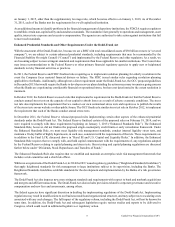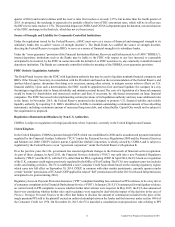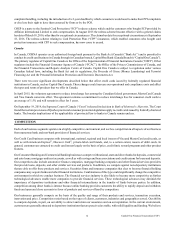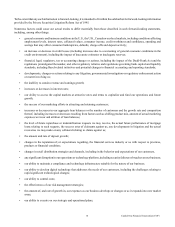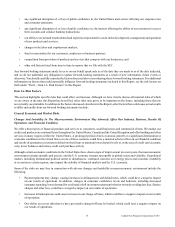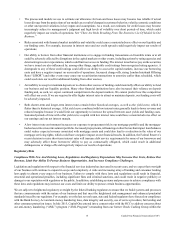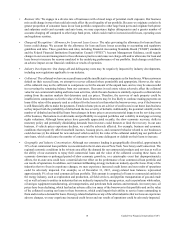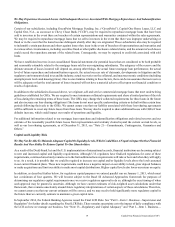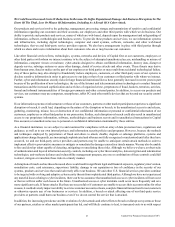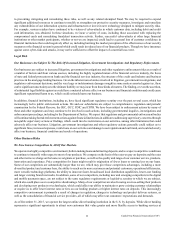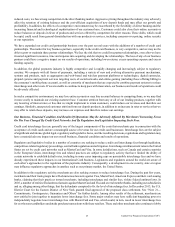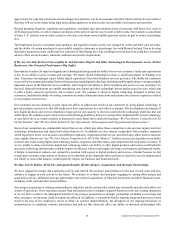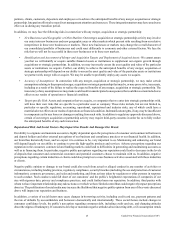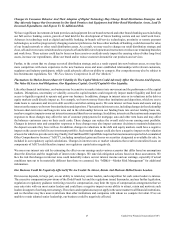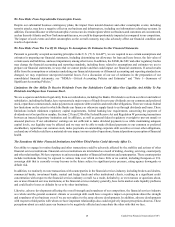Capital One 2015 Annual Report Download - page 37
Download and view the complete annual report
Please find page 37 of the 2015 Capital One annual report below. You can navigate through the pages in the report by either clicking on the pages listed below, or by using the keyword search tool below to find specific information within the annual report.18 Capital One Financial Corporation (COF)
• Business Mix: We engage in a diverse mix of businesses with a broad range of potential credit exposure. Our business
mix could change in ways that could adversely affect the credit quality of our portfolio. Because we originate a relatively
greater proportion of consumer loans in our loan portfolio compared to other large bank peers and originate both prime
and subprime credit card accounts and auto loans, we may experience higher delinquencies and a greater number of
accounts charging off compared to other large bank peers, which could result in increased credit losses, operating costs
and regulatory scrutiny.
• Charge-off Recognition / Allowance for Loan and Lease Losses: The rules governing the allowance for loan and lease
losses could change. We account for the allowance for loan and lease losses according to accounting and regulatory
guidelines and rules. These guidelines and rules, including Financial Accounting Standards Board (“FASB”) standards
and the Federal Financial Institutions Examination Council (“FFIEC”) Account Management Guidance, could require
changes in our account management or loss allowance practices and cause our charge-offs and/or allowance for loan and
lease losses to increase for reasons unrelated to the underlying performance of our portfolio. Such changes could have
an adverse impact on our financial condition or results of operation.
• Industry Developments: Our charge-off and delinquency rates may be negatively impacted by industry developments,
including new regulations applicable to our industry.
• Collateral: The collateral we have on secured loans could be insufficient to compensate us for loan losses. When customers
default on their secured loans, we attempt to recover collateral where permissible and appropriate. However, the value
of the collateral may not be sufficient to compensate us for the amount of the unpaid loan, and we may be unsuccessful
in recovering the remaining balance from our customers. Decreases in real estate values adversely affect the collateral
value for our commercial lending and home loan activities, while the auto business is similarly exposed to collateral risks
arising from the auction markets that determine used car prices. Therefore, the recovery of such property could be
insufficient to compensate us for the value of these loans. Borrowers may be less likely to continue making payments on
loans if the value of the property used as collateral for the loan is less than what the borrower owes, even if the borrower
is still financially able to make the payments. Trends in home prices are a driver of credit costs in our home loan business
as they impact both the probability of default and the loss severity of defaults. Additionally, the potential volatility in the
number of defaulted and modified loans from changes in home prices can create material impacts on the servicing costs
of the business, fluctuations in credit marks and profitability in acquired portfolios and volatility in mortgage servicing
rights valuations. Although home prices have generally appreciated recently, the slow economic recovery, shifts in
monetary policy and potentially diminishing demands from investors could threaten or limit the recovery. In our auto
business, if vehicle prices experience declines, we could be adversely affected. For example, business and economic
conditions that negatively affect household incomes, housing prices, and consumer behavior related to our businesses
could decrease (i) the demand for new and used vehicles and (ii) the value of the collateral underlying our portfolio of
auto loans, which could cause the number of consumers who become delinquent or default on their loans to increase.
• Geographic and Industry Concentration: Although our consumer lending is geographically diversified, approximately
31% of our commercial loan portfolio is concentrated in the tri-state area of New York, New Jersey and Connecticut. The
regional economic conditions in the tri-state area affect the demand for our commercial products and services as well as
the ability of our customers to repay their commercial loans and the value of the collateral securing these loans. An
economic downturn or prolonged period of slow economic growth in, or a catastrophic event that disproportionately
affects, the tri-state area could have a material adverse effect on the performance of our commercial loan portfolio and
our results of operations. In addition, our Commercial Banking strategy includes an industry-specific focus. If any of the
industries that we focus in experience changes, we may experience increased credit losses and our results of operations
could be adversely impacted. For example, as of December 31, 2015, energy-related loan balances represented
approximately 5% of our total commercial loan portfolio. This amount is comprised of loans to commercial entities in
the energy industry, such as exploration and production, oil field services, and pipeline transportation of gas and crude
oil, as well as loans to entities in industries that are indirectly impacted by energy prices, such as petroleum wholesalers,
oil and gas equipment manufacturing, air transportation, and petroleum bulk stations and terminals. In recent years, oil
prices have been declining, which has had an adverse effect on many of the borrowers in this portfolio and on the value
of the collateral securing our loans to these borrowers, which could impair their ability to service loans outstanding to
them and/or reduce demand for loans. If energy-related industries or any of the other industries that we focus on experience
adverse changes, we may experience increased credit losses and our results of operations could be adversely impacted.


